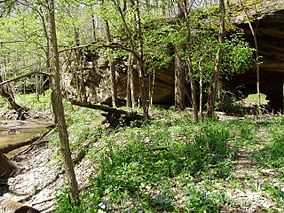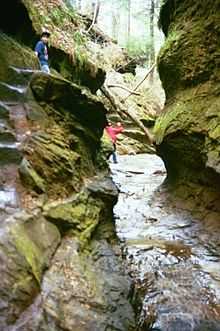| |
Name |
Image |
Date |
Location |
County |
Description |
|---|
| 1 |
Big Walnut Creek |
|
01968-01-01-00001968 |
Bainbridge39°47′48″N 86°46′39″W / 39.796749°N 86.777474°W / 39.796749; -86.777474 (Big Walnut Creek) |
Putnam |
Contains one of the few stands in Indiana where beech, sugar maple, and tulip poplar grow on alluvial Genesee soil. |
| 2 |
Cabin Creek Raised Bog |
|
01974-01-01-00001974 |
Farmland40°08′13″N 85°07′33″W / 40.1368101°N 85.1257457°W / 40.1368101; -85.1257457 (Cabin Creek Raised Bog) |
Randolph |
One of the few known inland raised bogs in the United States. It has a very rich flora including many species at or near their range limits. |
| 3 |
Calvert and Porter Woods |
|
01974-01-01-00001974 |
New Ross40°01′22″N 86°43′19″W / 40.0228369°N 86.7218275°W / 40.0228369; -86.7218275 (Calvert and Porter Woods) |
Montgomery |
One of the finest near-virgin remnant forests in the Tipton Till Plain of central Indiana. |
| 4 |
Cowles Bog |
 |
01965-01-01-00001965 |
Chesterton41°38′15″N 87°05′32″W / 41.6375°N 87.092222°W / 41.6375; -87.092222 (Cowles Bog) |
Porter |
Part of the Indiana Dunes National Lakeshore, this is the sole remaining remnant of the Central Dunes where Henry Chandler Cowles performed his pioneering field studies of plant succession and species diversity. |
| 5 |
Davis-Purdue Agriculture Center Forest |
|
01974-01-01-00001974 |
Farmland40°15′12″N 85°08′53″W / 40.2533425°N 85.1480344°W / 40.2533425; -85.1480344 (Davis-Purdue Agriculture Center Forest) |
Randolph |
The best old growth oak-hickory forest on the Tipton Till Plain. |
| 6 |
Donaldson Cave System and Woods |
|
01972-01-01-00001972 |
Mitchell38°43′49″N 86°24′55″W / 38.73022°N 86.4153307°W / 38.73022; -86.4153307 (Donaldson Cave System and Woods) |
Lawrence |
Spring Mill State Park-A stream flows from a cave through the bottom of a gorge. |
| 7 |
Dunes Nature Preserve |
 |
01974-01-01-00001974 |
Porter41°40′N 87°02′W / 41.66°N 87.04°W / 41.66; -87.04 (Dunes Nature Preserve) |
Porter |
Indiana Dunes State Park-Inter-dunal wetlands and blowouts along Lake Michigan |
| 8 |
Fern Cliff Nature Preserve |
|
01980-01-01-00001980 |
Greencastle39°36′40″N 86°57′49″W / 39.610985°N 86.96366°W / 39.610985; -86.96366 (Fern Cliff Nature Preserve) |
Putnam |
Contains exceptional occurrences of mosses and liverworts, including a noteworthy number of rare species. |
| 9 |
Hanging Rock and Wabash Reef |
 |
01986-01-01-00001986 |
Lagro40°49′48″N 85°42′26″W / 40.83°N 85.70722°W / 40.83; -85.70722 (Hanging Rock and Wabash Reef) |
Wabash |
Contains an impressive natural exposure of fossilized coral reef dating from the Silurian Period some 400 million years ago. The limestone reef deposit rises 75 feet (23 m) above the river and is being undercut by it, giving the site its "hanging" appearance. |
| 10 |
Harrison Spring |
 |
01980-01-01-00001980 |
Depauw38°14′41″N 86°13′31″W / 38.244755°N 86.225143°W / 38.244755; -86.225143 (Harrison Spring) |
Harrison |
A portion of the water that feeds the spring originates from Indian Creek, and then goes underground until it reaches the spring area. It produces at least 3 million gallons of water a day at an average of 18,000 gpm, enough to supply water to an average town of 12,000 |
| 11 |
Hemmer Woods |
|
01973-01-01-00001973 |
Oakland City38°13′51″N 87°22′15″W / 38.230768°N 87.370935°W / 38.230768; -87.370935 (Hemmer Woods) |
Gibson |
Original southwestern Indiana oak-hickory forest. |
| 12 |
Hoosier Prairie |
 |
01974-01-01-00001974 |
Griffith41°31′22″N 87°27′27″W / 41.522683°N 87.457572°W / 41.522683; -87.457572 (Hoosier Prairie) |
Lake |
Part of the Indiana Dunes National Lakeshore - Wetland prairie remnant of sand plains, sedge meadows, and marshes. |
| 13 |
Hoot Woods |
|
01973-01-01-00001973 |
Freedom39°15′00″N 86°53′22″W / 39.249897°N 86.889462°W / 39.249897; -86.889462 (Hoot Woods) |
Owen |
A relatively undisturbed, isolated beech-maple forest in which near climax conditions prevails. |
| 14 |
Kramer Woods |
|
01973-01-01-00001973 |
Reo37°50′38″N 87°08′17″W / 37.843932°N 87.137981°W / 37.843932; -87.137981 (Kramer Woods) |
Spencer |
The only example of a Shumard's red oak-pin oak-hickory dominated stand of lowland mixed forest of any size in Indiana. |
| 15 |
Marengo Cave |
 |
01984-01-01-00001984 |
Marengo38°22′32″N 86°20′24″W / 38.37555°N 86.33993°W / 38.37555; -86.33993 (Marengo Cave) |
Crawford |
One of only four show caves in Indiana, public tours of the cave have been given since 1883. Tours commenced just days after the cave's discovery by two school children. |
| 16 |
Meltzer Woods |
|
01973-01-01-00001973 |
Shelbyville39°30′10″N 85°40′04″W / 39.5028°N 85.6678°W / 39.5028; -85.6678 (Meltzer Woods) |
Shelby |
Contains two contrasting forest types and exceptionally large individuals of several tree species. |
| 17 |
Officer's Woods |
|
01974-01-01-00001974 |
Seven miles northwest of Madison [2] |
Jefferson |
One of the finest remnants of beech-maple forest south of the Wisconsin-age glacial boundary in Indiana. Contains two stands which differ slightly in composition, one of which contains an exceptionally high density of black gum. |
| 18 |
Ohio Coral Reef |
 |
01966-01-01-00001966 |
Clarksville38°16′36″N 85°45′56″W / 38.27665°N 85.76544°W / 38.27665; -85.76544 (Ohio Coral Reef National Natural Landmark) |
Floyd |
A classic example of a Silurian and Devonian coral community. Extends into Kentucky. |
| 19 |
Pine Hills Natural Area |
 |
01968-01-01-00001968 |
Waveland39°56′34″N 87°02′58″W / 39.94276°N 87.049348°W / 39.94276; -87.049348 (Pine Hills Natural Area) |
Montgomery |
Shades State Park- Deep gorges, the result of the last glacial meltwaters. |
| 20 |
Pinhook Bog |
 |
01965-01-01-00001965 |
Michigan City41°36′54″N 86°50′54″W / 41.615°N 86.848333°W / 41.615; -86.848333 (Pinhook Bog) |
LaPorte |
Indiana Dunes National Lakeshore-bog formed from a postglacial kettle moraine left behind about 14,000 years before the present by the melting of the ice sheet during the end of the Wisconsin glaciation. The acidic bog is noted for pitcher plants and other wetland species. |
| 21 |
Pioneer Mothers Memorial Forest |
|
01974-01-01-00001974 |
Paoli38°32′10″N 86°27′32″W / 38.536°N 86.459°W / 38.536; -86.459 (Pioneer Mothers Memorial Forest) |
Orange |
One of the best examples of an original, undisturbed presettlement forest in Indiana. |
| 22 |
Portland Arch Nature Preserve |
 |
01973-01-01-00001973 |
Covington40°13′07″N 87°20′09″W / 40.218611°N 87.335833°W / 40.218611; -87.335833 (Portland Arch) |
Fountain |
The preserve encompasses the wooded valleys, ravines and rocky cliffs around the lowest section of Bear Creek. The name comes from a natural sandstone bridge carved by a small tributary of Bear Creek. |
| 23 |
Rise at Orangeville |
|
01972-01-01-00001972 |
West Baden Springs38°37′52″N 86°33′26″W / 38.63115°N 86.55711°W / 38.63115; -86.55711 (Orangeville Rise) |
Orange |
Orangeville Rise of Lost River Nature Preserve is the second largest spring in the state of Indiana. |
| 24 |
Rocky Hollow Falls Canyon Nature Preserve |
 |
01974-01-01-00001974 |
Marshall39°53′37″N 87°12′17″W / 39.893739°N 87.204589°W / 39.893739; -87.204589 (Rocky Hollow Falls Canyon Nature Preserve) |
Parke |
Rocky Hollow and Falls Canyon are two of a series of canyons cut into the sandstone of Turkey Run. |
| 25 |
Shrader-Weaver Woods |
|
01974-01-01-00001974 |
Bentonville39°43′13″N 85°13′20″W / 39.720309°N 85.222321°W / 39.720309; -85.222321 (Shrader-Weaver Nature Preserve) |
Fayette |
Shrader-Weaver Nature Preserve - Old growth beech-maple forest with a pioneer homestead. Includes tulip, wild black cherry and black walnut trees. |
| 26 |
Tamarack Bog |
|
01973-01-01-00001973 |
Mongo41°40′35″N 85°15′44″W / 41.676361°N 85.262314°W / 41.676361; -85.262314 (Tamarack Bog Nature Preserve) |
LaGrange |
Tamarack Bog Nature Preserve, Pigeon River Fish and Wildlife Area - Large tamarack tree swamp |
| 27 |
Tolliver Swallowhole |
|
01972-01-01-00001972 |
Orleans38°36′58″N 86°29′41″W / 38.616197°N 86.494599°W / 38.616197; -86.494599 (Tolliver Swallow Hole) |
Orange |
An extraordinary example of the disappearing stream aspect of karst topography. |
| 28 |
Wesley Chapel Gulf (Elrod Gulf) [3] |
|
01972-01-01-00001972 |
Orleans38°37′21″N 86°31′19″W / 38.622452°N 86.521906°W / 38.622452; -86.521906 (Wesley Chapel Gulf (Elrod Gulf)) |
Orange |
Probably the largest sinkhole in Indiana. |
| 29 |
Wesselman Woods Nature Preserve |
|
01973-01-01-00001973 |
Evansville37°59′05″N 87°30′22″W / 37.984722°N 87.506111°W / 37.984722; -87.506111 (Wesselman Park Nature Center) |
Vanderburgh |
Wesselman Woods Nature Preserve - southern old growth forest |
| 30 |
Wyandotte Caves |
 |
01972-01-01-00001972 |
Leavenworth38°13′41″N 86°17′46″W / 38.228056°N 86.296111°W / 38.228056; -86.296111 (Wyandotte Caves) |
Crawford |
O'Bannon Woods State Park/Harrison-Crawford State Forest - Wyandotte caves began to form in the Pliocene Era, about 2 million years ago. Like most of Southern Indiana's caves, the caves were formed when water dissolved limestone, causing hollow caves to form. |
|








